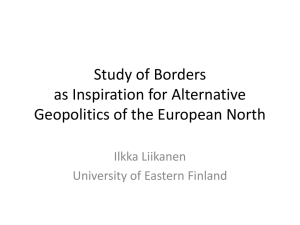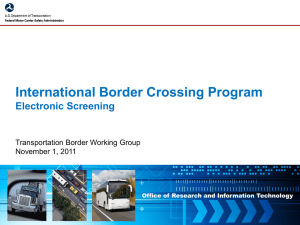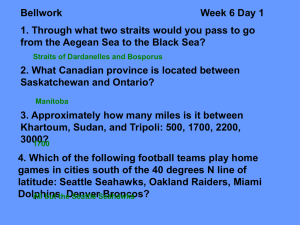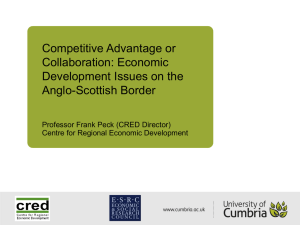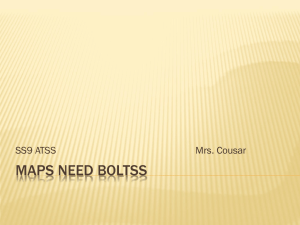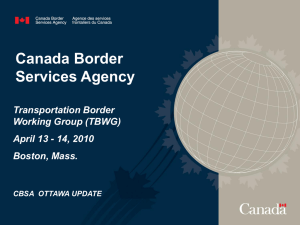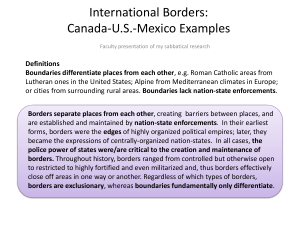Exploring integration space
advertisement
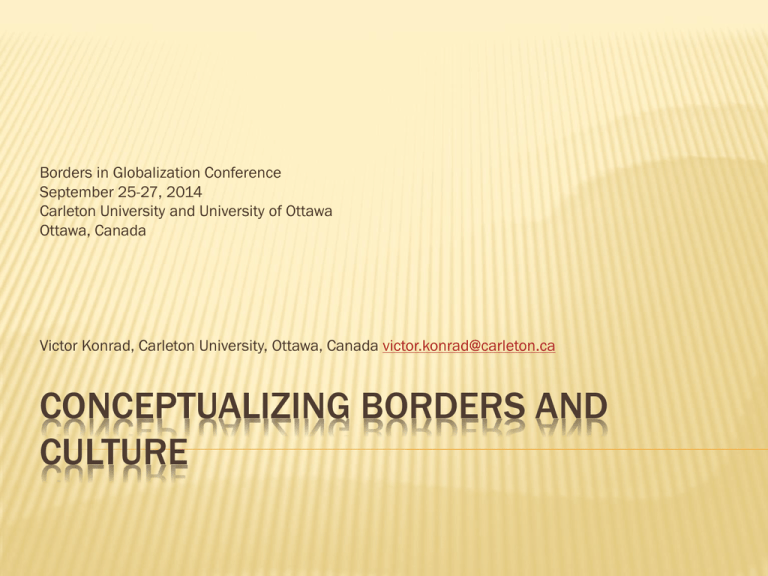
Borders in Globalization Conference September 25-27, 2014 Carleton University and University of Ottawa Ottawa, Canada Victor Konrad, Carleton University, Ottawa, Canada victor.konrad@carleton.ca CONCEPTUALIZING BORDERS AND CULTURE THE CULTURAL BORDER Anachronism of the Wagah border ceremony in the internetconnected world Perform and ritualize incised border Border, territory and culture all demarcated BORDER CULTURE Talking Borders gives voice to communities in border areas of Sierra Leone, Liberia and Guinea Territory, borders and culture blurred after years of war and diaspora Objectives: 1. Interrogate critically the interaction of borders and culture, and to evaluate how notions of border culture, cultural borders and borderlands culture emerged in the establishment and successive development of anthropology, geography and geopolitics 2. Explore the meaning of imagining across boundaries: Imagine intersection of borders and culture? Articulation of imprints? Manifestation of imaginaries? 3. Assess border culture production, materialization, building at border and in borderlands INTERACTION OF CULTURE AND BORDERS AND THE EMERGENCE OF BORDER CULTURE The border is at the nexus of the international and transnational, territorial and extraterritorial, and political and socio- cultural (Fein, 2003) Borders ’work’ extensively in a globalizing world of contact zones, asymmetrical relationships, increasing flows and displacements Culture related to and influenced by power (Mitchell, 2000) but need to problematize and define how power and culture interrelate Not just ”all politics is cultural and all culture is political” Left unfulfilled in understanding of how and what culture manifests as it intersects with borders Transnational regimes of knowledge (Foucault) key forms of international power and also key elements in defining border culture (Konrad and Nicol, 2011) Understanding border culture entails relating international forces operating between nations to transnational forces produced by the presence of one nation within another (Fein, 2003) To capture both the ”essential” and the ”imagined” qualities of hybridization and differentiation at borders and in borderlands (Shimoni, 2006) POWER, TERRITORY AND BORDERS Thinking about border culture and cultural borders needs to be located within the evolving thought about territory, borders and culture that has migrated vicariously between the fields of anthropology and geography since their inception. If The Birth of Territory (Elden, 2013) is a ”political technology”, how do we conceptualize border culture emerging in a world of increasing flows? May border culture be conceptualized as the agency of political technology enabling both territorial delimitation and amelioration? In hindsight, one of the great misconceptions in both classical geopolitics and cultural antropology was to view the nation and the state as bounded territory. • ”Raum” is political and cultural space and container of organic state which would ultimately expand and grow beyond its boundaries • Organic state theory to ”lebensraum” to ”weltmacht” (influenced by Malthus, Darwin, Spencer, Turner) • Culture becomes super organic • Borders become insignificant and recede before the flow of organized, enlightened, resourceful and entitled people • Frontier is a zone of transition and peripheral organ of the state (Cahnman 1944) • Border culture and the cultural border born in Ratzel’s intertwining of anthropology, politics and geography • Ideologically extended and twisted by Kjellen and Haushofer into ”lebensraum” • Mackinder and Spykman bring frontiers back into the discourse of geopolitics • Minghi (1963) rebuilds groundwork for border studies in political geography; Meinig (1970) relates culture and territory RATZEL, THE ’SUPER ORGANIC’, AND CULTURE INHABITING AND OVERFLOWING TERRITORY CULTURAL BOUNDARIES COTERMINOUS WITH ’NATION’ AND ETHNIC DELINEATIONS CONCURRENTLY SEPARATING CULTURE AREAS AND DIFFERENTIATING CULTURAL TRAITS CULTURAL RELATIVISM TRANSITION AND HYBRIDIZATION? FRANZ BOAS CULTURE DEVELOPS ITS OWN UNIQUE STYLE SYSTEMS STYLE SYSTEMS BECOME FIXED, CLIMAX, FATIGUE AND DECLINE TERRITORIES AND BORDERS IMPLICIT IF NOT EXPLICIT CULTURAL BOUNDARY COTERMINOUS WITH NATIONAL BORDER A. L. KROEBER CULTURAL AND SPATIAL TURNS: IF CULTURES ARE SEPARATE LONG ENOUGH A BORDER WILL FORM; IF CULTURES ARE SEPARATE ENOUGH A BORDER WILL FORM Border is symbol of power which differentiates it from a boundary (Erickson 1997, Chang 2010) Differentiation of cultural border and cultural boundary on basis of imagination as well as power (Johnson and Michaelson 1997) Borderlands transnational imaginary (Saldivar 2006) Borderlands liminal and hybrid spaces (Bhabha 1994, Kraidy 2005) Borderlands cultures do not revert (Gupta and Ferguson 1992,1997) Influenced by post structuralists Foucault, Derrida, Butler, Lacan, Deleuze and others Cultural turn has liberated concept of border culture from its anthropo-geographical anchoring at the intersection of classical geopolitics, emergent geography and incipient anthropology, refreshed with re-vitalized exploration of identity, affinity and imagination EXPLORING THE CULTURAL IMAGINARY AT BORDERS AND IN BORDERLANDS Cultural research on borders and borderlands seeks the meaning of imagining across boundaries What clusters of attention and thinking are emerging? Culture is socially constructed and thus imagined Cultural imaginaries evolve in hybrid forms and distinct expressions in border areas Cultural rigidities become flexibilities or stronger rigidities Border imaginaries vary greatly Imaginaries are constantly in motion But, there is a sense of boundaries and people keep their cultural borders not as essential but as imagined phenomena Cultural imaginaries at the border and in the borderlands link with the cultural meaning of landscape, aesthetics, identities, belonging, settlement, community, migration, work, play, stories and other forms of borderlands experience. Many ways to organize and assemble cultural expressions and affiliations. Offer following groupings: 1. 2. 3. Life sustaining Life enriching Life securing 1. LIFE SECURING CULTURAL IMAGINARIES Land and life in borderlands is different than in heartland Cultural imaginaries required to first secure life in the cross-border region (these are not the imaginaries of the central state) Protection of land and property in resistance to appropriation from the nation state, food security, confirmed livelihood Threats often visualized and materialized as threats from the nation-state, and resistance is to the state (Juarez/El Paso; West Bank/Israel) Example: scaled engagement, linkage of domestic and international at Canada-US border 2. LIFE SUSTAINING CULTURAL IMAGINARIES Integral to the everyday routine of managing flow of people, goods and ideas of symbiotic if not integrated economic, social and cultural zone of interaction Need to embrace imaginary of the border as facilitation zone/line rather than space of exclusion Sustaining life in the borderlands engages most border provinces and communities Illustration: the new New International Trade Crossing bridge between Detroit and Windsor Locally grown and shared crossborder imaginary of life sustaining interaction needs to emerge 3. LIFE ENRICHING CULTURAL IMAGINARIES Form through mutual engagement and linkage of creative people and agencies across boundary and in borderlands Cultural imaginaries more characteristically developed in borderlands in reaction to state neglect or direct state suppression Illustration: the NFL in Toronto, Canada Cultural imaginaries maintain and cross other borders for both intragroup cohesion across international boundary and extra-group display of affiliation across the cultural border Cultural imaginary that enriches life becomes the crucible for life sustaining and life securing imaginaries as well CULTURAL PRODUCTION, MATERIALIZATION AND HERITAGE AT THE BORDER AND IN THE Dramatic increase in walls, fences and BORDERLANDS barriers at boundaries, overall hardening of borders to protect interests of privileged few who actually live the promise of globalization and defend its privileges through teichopolitics (Rosiere and Jones, 2012) Growing attention devoted to cultural implications of re-emergence of border walls: walls do not work; symbols of resistance to the constructions themselves Canvas for displaying reaction as both a political act and a cultural materialization (examples: Mexico, Israel) Dear, 2013; Amilhat-Szary, 2012: hybridity, ’third nation’, new border culture of intertwined identities and daily transnational and transcultural interaction, physical manifestations of fear of incursion, national identity, symbolic cohesion THE PROBLEM WITH A WALL IS THAT IT MATERIALIZES AS A LOT TO LEAVE BEHIND WHEN IT IS NO LONGER FUNCTIONAL OR ITS PURPOSE HAS WANED. Essentialized or materialized Cultural production either essentialized or imagined Realization brings us to consider what we bring to the border and what we leave behind Imaginaries either brought to border or fashioned in borderlands Expressed as cultural identity or facets of transnational identities performed or otherwise realized at the border These are extensive imaginaries consistent with vast and growing domains of transnationalism and borderlands culture components of cultural production reinforce identity and belonging, and work as symbols of border culture Both imagined and materialized border culture is potentially border culture heritage: statements and clues to who we are and how we have negotiated the borderlands Some ephemeral: garbage of illegal migrants (Sundberg, 2008) Symbols of cold selectivity of U.S. Mexico borderlands and Mediterranean ’death zones’ Era of security primacy commemorated by an array of artifacts: heritage of why we did this, and who we were! BORDER CULTURE, CULTURAL IMAGINARIES AND THE CULTURAL HERITAGE OF THE BORDERLANDS Fed by transnational flows, society and culture in each of the world’s 200 nation states are interconnecting with societies and cultures in all other units to form transnational societies and transnational cultures. What happens at the borders? Studies show that results are highly variable Culture constructed both within and across boundaries to galvanize nationalism and to extend beyond nationalism If culture precedes borders hybridization and restiching occur Border culture, however, very difficult to define as is culture Re-thinking border culture led us back to emergence of geographical and anthropological conceptualizations of territory: seeds of several modern and post-modern ideas about how cultures emerge and connect Understanding border culture: relate international forces operating within nations with transnational forces produced by the presence of one nation within another to capture both the material and imagined hybridization and differentiation Resonance of symbolic power Cultural turn liberated concept of border culture, and refreshed it with identity, belonging, affinity considerations, and imaginaries BORDERLANDS CULTURE Cultural imaginary links with the meaning of identity land and life to secure, sustain and enrich life in borderlands and beyond Security, sustainability and enrichment of vital importance with re-emergence of walls, fences, barriers: ‘third’ nations centered on the wall that would divide them Polarization, juxtaposition of secured and nonsecured spaces and places caused by these dialectics affinity Yet, imagination Crucible of Borderlands Culture Social cohesion works in isolation Integration space grows and pulses Communities and loops work Mediation operates from bottom-up Local and regional scale perseveres Liminal culture spaces coalesce Left with a cultural heritage of borders that is problematical at best, potentially devastating if border dialectic not addressed and mediated by imaginaries that offer to secure, sustain and enrich life at the border and in the borderlands OUR GOAL, ULTIMATELY, IS TO UNDERSTAND MORE ABOUT THE INTERPLAY OF BORDERLANDS CULTURAL IMAGINARIES AND MATERIALIZATIONS AT THE PLACES AND IN THE SPACES WHERE NATION-STATES MEET AND INTERACT. Approach goal with social scientific conceptualizations and sensitivities gained from humanities Salter (2013) argues that the suture better captures the dual worldcreating functions of the border: suture (or /) conveys evocative knitting together inside and outside, signifies and empowers the role of / in cybernetic world, both as agent of separation and integration Will borders become a bewildering array of binary cues linked to bar codes intelligible only to computers? Or, does interplay of borders and culture create melodies, songs and perhaps symphonies of interaction to interprete? (Border Songs, Lynch, 2008) THE LANGUAGE AND STRUCTURE OF BORDER SONGS MAY BE ELUSIVE AND DIFFICULT TO UNDERSTAND BUT WE CAN ALL COMPREHEND AND APPRECIATE THE MUSIC.

